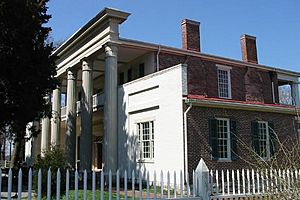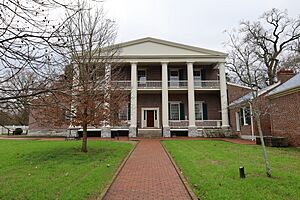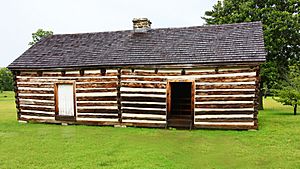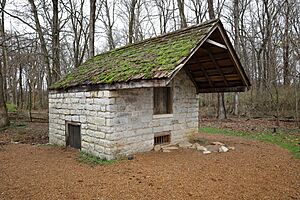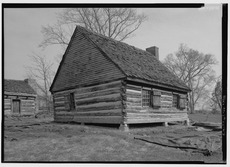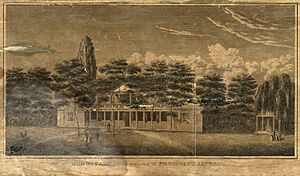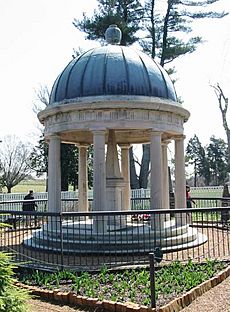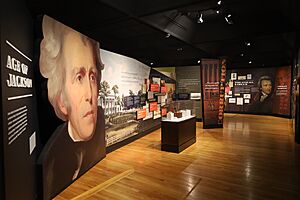The Hermitage (Nashville, Tennessee) facts for kids
|
The Hermitage
|
|
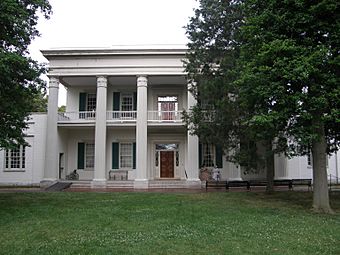
Front of the mansion in 2007
|
|
| Location | 4580 Rachel's Ln Hermitage, TN 37076 |
|---|---|
| Area | 1,120 acres (450 ha) |
| Built | 1835 (current form) |
| Architect | Joseph Reiff and William C. Hume |
| Architectural style | Greek Revival |
| NRHP reference No. | 66000722 |
Quick facts for kids Significant dates |
|
| Added to NRHP | October 15, 1966 |
| Designated NHL | December 19, 1960 |
The Hermitage is a famous historic home and museum in Davidson County, Tennessee. It's about 10 miles east of downtown Nashville. This large property, over 1,000 acres, was once owned by Andrew Jackson. He was the seventh president of the United States.
President Jackson owned The Hermitage from 1804 until he passed away there in 1845. He is also buried on the grounds. Jackson lived at the property on and off until he retired from public life in 1837.
Many enslaved people lived and worked at The Hermitage. When Jackson bought the land in 1804, nine enslaved people were there. By the time he died, 110 enslaved individuals lived on the plantation. They mostly grew cotton, which was the main crop sold from the farm.
The Mansion and Its Surroundings
How the Mansion Was Built
The Hermitage is in a quiet meadow. President Jackson's wife, Rachel, chose this spot for their home. From 1804 to 1821, they lived in a simple log cabin here. This cabin and a few others were known as the First Hermitage.
Later, Jackson wanted a grander home. The first main house was a two-story, Federal-style mansion. It was built with bricks made right on the property between 1819 and 1821. The house had four rooms on each floor, all with fireplaces.
In 1831, while Jackson was president, the house was updated. Architect David Morrison helped change it to a Classical style. It got new one-story wings and a large entrance porch with 10 columns.
A fire in 1834 badly damaged the house. Only the dining room wing was saved. After the fire, Jackson hired architects Joseph Reiff and William C. Hume. They designed a new 13-room, Greek Revival mansion. It was built on the old foundation and finished two years later.
The mansion is shaped like a rectangle. The front entrance faces south. It has a central part with two stories and a porch. This porch is held up by six large wooden columns. One-story wings extend out from the main house. The front of the house looks like it has a flat roof. However, the other sides show it has a sloped roof covered in tin. The front was painted a light tan. Sand was added to the columns to make them look like stone. A similar porch is on the north side of the house.
Inside the Mansion
The main part of the house has four big rooms. They are separated by a central hallway. The entry hall has dark painted wooden floors. Its wallpaper shows scenes from an old story about Telemachus. At the end of the hall, a beautiful staircase leads upstairs.
To the left of the hall are the front and back parlors. These rooms have fancy crystal chandeliers and marble fireplaces. From the front parlor, you can enter the dining room in the east wing.
The dining room has shiny paint to make it bright. Its fireplace has a special mantelpiece called the "Eighth of January." A soldier from the Battle of New Orleans carved it. He worked on it every year on the battle's anniversary. Jackson put it in place on January 8, 1840. Next to the dining room is a pantry and storage room. This leads to an open path to the kitchen. The kitchen was built separately to keep fire, noise, heat, and smells away from the main house.
To the right of the entrance hall are two bedrooms. President Jackson and his son, Andrew Jackson, Jr., used these rooms. A large library and office are in the west wing. Jackson used this area to manage the property.
Upstairs, there are four more bedrooms. Family members and guests used these rooms. Famous visitors included Sam Houston and Presidents James K. Polk and Martin Van Buren.
The Grounds and Gardens
Today, The Hermitage covers 1,120 acres. This includes most of Jackson's original land. The Andrew Jackson Foundation now manages the site. A cedar-lined, 10-foot-wide driveway leads to the mansion. It was designed to make it easy for carriages to turn around.
East of the house is a 1-acre formal garden. A gardener from Philadelphia designed it in 1819. It has four main sections and a round center flower bed. The garden was first used to grow food for the mansion. It was also a beautiful place for enjoyment. A white picket fence surrounds it. A brick outhouse, a fancy toilet building, stands on the north side.
After Rachel Jackson passed away in 1828, Jackson buried her in the garden she loved. When he remodeled the house in 1831, he also built a special "temple & monument" for Rachel's grave. This domed limestone tomb with a copper roof was finished in 1832.
Behind the mansion, there is a smokehouse from the early 1800s. This large brick building cured about 20,000 pounds of pork each year. Nearby is a log cabin called Uncle Alfred's Cabin. Alfred Jackson was born enslaved at The Hermitage around 1812. He worked there in many roles. After the Civil War, he stayed on the property. He later became a caretaker and guide when the Ladies' Hermitage Association bought the estate in 1889. Alfred Jackson passed away in 1901 and is buried near President and Mrs. Jackson.
Two other cabins were built using materials from the First Hermitage. After Jackson built the main house, his old two-story log home was taken apart. Its wood was used to build two one-story buildings for workers.
From 1988 to 2005, archaeologists studied the site. They found an ice house behind the smokehouse. They also uncovered hundreds of thousands of artifacts. A brick building with three units, likely used by workers, was found near the mansion. Archaeologists have identified 13 places where workers lived.
History of The Hermitage
The Cotton Farm
| Year | Enslaved
Population |
What We Know | Where Data Was Recorded |
|---|---|---|---|
| 1804 | 9 | (When the land was bought) | |
| 1820 | 44 | 1820 U.S. Census | |
| 1825 | 80 | Davidson County tax list | |
| 1829 | 95 | 17 women, 19 men,
59 children (age 19 and under) |
Hermitage Farm Journal |
| 1830 | 94 | 1830 U.S. Census | |
| 1840 | 105 | 1840 U.S. Census | |
| 1845 | 110 | Andrew Jackson probate inventory | |
| 1850 | 137 | 29 women, 19 men,
51 children (age 19 and under) |
1850 U.S. Census |
The land Jackson named Hermitage was near the Cumberland and Stones Rivers. Settlers had moved into the area in the late 1700s. Robert Hays first settled this land in 1780. He sold his 420-acre farm to Jackson in 1804. Jackson later bought more land, making the plantation even bigger.
Jackson and his wife moved into an existing log blockhouse. It was built to protect against attacks. They added a lean-to and other log buildings. These included cabins for enslaved people, storage rooms, and a smokehouse. This area was called the First Hermitage. Jackson started his cotton farm with nine enslaved African people. He continued to buy more workers. By 1820, he owned 44 enslaved people. This made him a major planter in middle Tennessee. Most farmers in the area owned fewer than 10 enslaved people.
Some cabins for enslaved house servants and skilled workers were near the main house. Most of the cabins for field laborers were closer to the cotton fields. This area was known as the Field Quarter.
In 1818–1819, Jackson built a brick house to replace his log home. He also added six brick buildings. These contained 13 living units for enslaved workers. One three-unit building, called the Triplex, was behind the mansion. A two-unit building, the South Cabin, was at the First Hermitage. Four brick duplexes were built at the Field Quarter.
Jackson was elected President in 1828. He made The Hermitage larger during his first term. After the 1834 fire, he rebuilt and refurnished the house. Jackson retired to The Hermitage in 1837 after his second term. He passed away there in 1845. Andrew Jackson was buried in the garden next to his wife.
Throughout his life, Jackson expanded the property to 1,000 acres. About 200 acres were used for growing cotton. The rest was for food and raising racehorses. By 1840, over 100 enslaved men, women, and children lived on the estate. This made it one of the largest estates in the region.
Jackson's adopted son, Andrew Jackson Jr., inherited the estate. Jackson's will also gave his son all the enslaved people, except a few given to his grandchildren and daughter-in-law. Because of debt, Jackson Jr. began selling parts of the estate. In 1856, he sold the remaining 500 acres, the mansion, and other buildings to the State of Tennessee. The Jackson family was allowed to stay as caretakers. The state planned to give the property to the federal government. It was meant to be a southern branch of the United States Military Academy. However, the American Civil War started in 1861 and stopped this plan.
The Civil War and After
During the Civil War, on May 5, 1863, soldiers from the Union Army visited The Hermitage. A soldier named Pvt. Joseph C. Taylor wrote in his diary about seeing the house and the tomb of General Jackson. He described the beautiful cedar-lined road and the garden. He noted the tomb of Andrew and Rachel Jackson in the southeast corner of the garden.
The Hermitage as a Museum
Andrew Jackson's grandson, Andrew Jackson III, and his family were the last to live at The Hermitage. They moved out in 1893. After that, The Hermitage became a museum. The Ladies' Hermitage Association took over the property. They wanted to preserve it as a museum about Jackson's life and the history of the South before the Civil War. The Association restored the mansion to look as it did in 1837. Over time, they bought back all the land that had been sold. By 2003, the property was back to its original size.
The Hermitage survived a big tornado in 1998. An F-3 tornado hit the property on April 16, 1998. It missed the house and grave site. But it knocked down 1,000 trees on the estate. Many of these trees were said to have been planted by Jackson himself almost 200 years earlier. These trees used to hide the house from the road. Now, the mansion can be seen clearly.
The mansion is one of the most accurately preserved early presidential homes in the country. Each year, over a quarter million people visit. This makes it the fourth-most-visited presidential home in the U.S. (after the White House, Mount Vernon, and Monticello). The property was named a National Historic Landmark in 1960.
In 2005, The Hermitage opened an exhibit about the lives of enslaved people on the plantation. This exhibit is in the Visitor Center. It shares more about the African American families who lived and worked there.
Memorial for Enslaved People
In 2006, the remains of 61 enslaved people were found near The Hermitage. These people had been legally owned by Rachel Jackson's nephews. Their graves were not marked. They were buried in family groups and ranged in age from 1 to 45. The Ladies' Hermitage Association reburied them in a new common grave at The Hermitage.
A memorial was built in 2009 to remember the enslaved people of the area. The design, called "Our Peace: Follow the Drinking Gourd—A Monument to the Enslaved," includes an unmarked stone wall over the burial site. It also has seven trees arranged like the Little Dipper constellation. Both the constellation and the phrase "follow the drinking gourd" refer to how enslaved people used the North Star to find their way to freedom.
Hermitage Slave Cemetery
In 2024, researchers found a burial ground believed to hold the graves of 28 enslaved people. Researchers had been looking for this cemetery for over 20 years. Some historians think that Lyncoya Jackson, a Native American boy adopted by Andrew Jackson, might have been buried in this slave cemetery.
Confederate Soldiers Home Cemetery
Part of The Hermitage estate became the site of the state-funded Confederate Soldiers Home. This was a place for poor and disabled Confederate veterans. It opened in 1892. More than 480 veterans who passed away there were buried in a cemetery on the property. Each grave has a white, military-style headstone. They are arranged in circles around a large stone monument.
Legacy of The Hermitage
The city in Davidson County where The Hermitage is located is named Hermitage, Tennessee. A hotel in downtown Nashville, called the Hermitage Hotel, opened in 1910 and is still open today. Many famous people and U.S. presidents have stayed there.
See also


